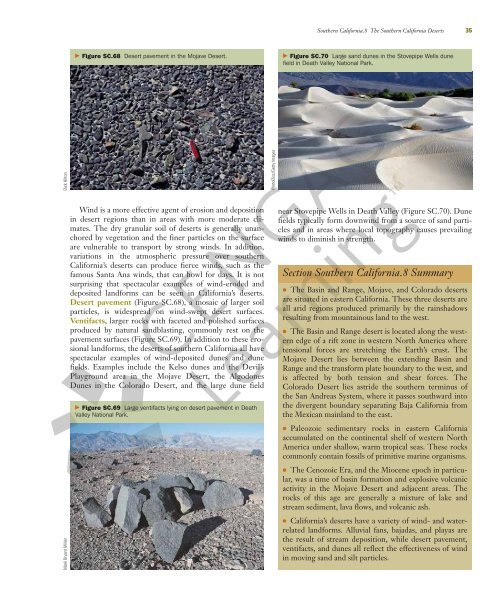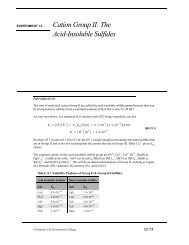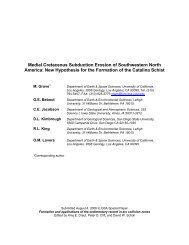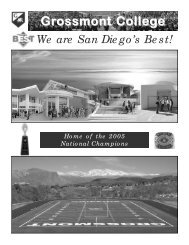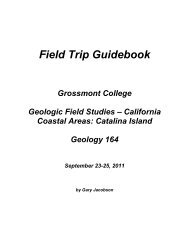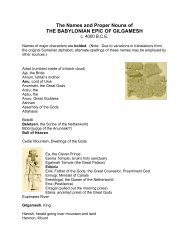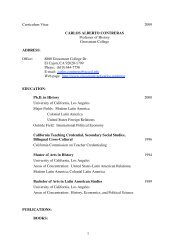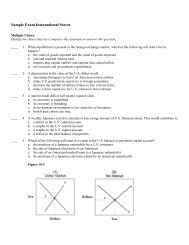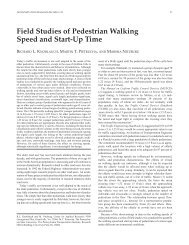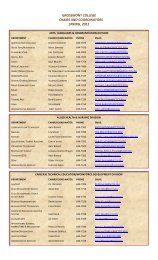Geology of Southern California.pdf - Grossmont College
Geology of Southern California.pdf - Grossmont College
Geology of Southern California.pdf - Grossmont College
Create successful ePaper yourself
Turn your PDF publications into a flip-book with our unique Google optimized e-Paper software.
Dick Hilton<br />
Marli Bryant Miller<br />
� Figure SC.68 Desert pavement in the Mojave Desert.<br />
Wind is a more effective agent <strong>of</strong> erosion and deposition<br />
in desert regions than in areas with more moderate climates.<br />
The dry granular soil <strong>of</strong> deserts is generally unanchored<br />
by vegetation and the finer particles on the surface<br />
are vulnerable to transport by strong winds. In addition,<br />
variations in the atmospheric pressure over southern<br />
<strong>California</strong>’s deserts can produce fierce winds, such as the<br />
famous Santa Ana winds, that can howl for days. It is not<br />
surprising that spectacular examples <strong>of</strong> wind-eroded and<br />
deposited landforms can be seen in <strong>California</strong>’s deserts.<br />
Desert pavement (Figure SC.68), a mosaic <strong>of</strong> larger soil<br />
particles, is widespread on wind-swept desert surfaces.<br />
Ventifacts, larger rocks with faceted and polished surfaces<br />
produced by natural sandblasting, commonly rest on the<br />
pavement surfaces (Figure SC.69). In addition to these erosional<br />
landforms, the deserts <strong>of</strong> southern <strong>California</strong> all have<br />
spectacular examples <strong>of</strong> wind-deposited dunes and dune<br />
fields. Examples include the Kelso dunes and the Devil’s<br />
Playground area in the Mojave Desert, the Algodones<br />
Dunes in the Colorado Desert, and the large dune field<br />
� Figure SC.69 Large ventifacts lying on desert pavement in Death<br />
Valley National Park.<br />
PhotoDisc/Getty Images<br />
<strong>Southern</strong> <strong>California</strong>.8 The <strong>Southern</strong> <strong>California</strong> Deserts 35<br />
� Figure SC.70 Large sand dunes in the Stovepipe Wells dune<br />
field in Death Valley National Park.<br />
near Stovepipe Wells in Death Valley (Figure SC.70). Dune<br />
fields typically form downwind from a source <strong>of</strong> sand particles<br />
and in areas where local topography causes prevailing<br />
winds to diminish in strength.<br />
Section <strong>Southern</strong> <strong>California</strong>.8 Summary<br />
● The Basin and Range, Mojave, and Colorado deserts<br />
are situated in eastern <strong>California</strong>. These three deserts are<br />
all arid regions produced primarily by the rainshadows<br />
resulting from mountainous land to the west.<br />
● The Basin and Range desert is located along the western<br />
edge <strong>of</strong> a rift zone in western North America where<br />
tensional forces are stretching the Earth’s crust. The<br />
Mojave Desert lies between the extending Basin and<br />
Range and the transform plate boundary to the west, and<br />
is affected by both tension and shear forces. The<br />
Colorado Desert lies astride the southern terminus <strong>of</strong><br />
the San Andreas System, where it passes southward into<br />
the divergent boundary separating Baja <strong>California</strong> from<br />
the Mexican mainland to the east.<br />
● Paleozoic sedimentary rocks in eastern <strong>California</strong><br />
accumulated on the continental shelf <strong>of</strong> western North<br />
America under shallow, warm tropical seas. These rocks<br />
commonly contain fossils <strong>of</strong> primitive marine organisms.<br />
● The Cenozoic Era, and the Miocene epoch in particular,<br />
was a time <strong>of</strong> basin formation and explosive volcanic<br />
activity in the Mojave Desert and adjacent areas. The<br />
rocks <strong>of</strong> this age are generally a mixture <strong>of</strong> lake and<br />
stream sediment, lava flows, and volcanic ash.<br />
● <strong>California</strong>’s deserts have a variety <strong>of</strong> wind- and waterrelated<br />
landforms. Alluvial fans, bajadas, and playas are<br />
the result <strong>of</strong> stream deposition, while desert pavement,<br />
ventifacts, and dunes all reflect the effectiveness <strong>of</strong> wind<br />
in moving sand and silt particles.


